Jiujiang
Jiujiang
九江市 Kiukiang | |
|---|---|
China Standard) | |
| ISO 3166 code | CN-JX-04 |
| Website | www |
| Jiujiang | |
|---|---|
Tâi-lô | Káu-kang |
Jiujiang (Chinese: 九江; lit. 'nine rivers'), formerly transliterated Kiukiang[3] or Kew Keang, is a prefecture-level city located on the southern shores of the Yangtze River in northwest Jiangxi Province, People's Republic of China. It is the second-largest prefecture-level city in Jiangxi province.
Jiujiang is one of the first five cities that were opened to foreign trade along the Yangtze River following the implementation of the reform and opening-up policy. It is the Yangtze River's shipping hub international gateway, and Jiangxi's only international trade port city. Jiujiang Port is the fourth largest port on the Yangtze River.[4][5]
Its population was 4,600,276 inhabitants at the
Administrative divisions

- Districts:
- Xunyang District(浔阳区)
- Lianxi District(濂溪区)
- Chaisang District(柴桑区)
- Counties:
- Wuning County (武宁县)
- Xiushui County (修水县)
- Yongxiu County (永修县)
- De'an County (德安县)
- Duchang County (都昌县)
- Hukou County (湖口县)
- Pengze County (彭泽县)
- Others:
- Bureau and Administration Committees
- Mount Lu Scenic Area Administration Bureau
- Mount Lu West Sea Scenic Area Management Committee
- Bali Lake New Area Management Committee
- Poyang Lake Ecological Science and Technology City Management Committee
- Towns and Sub-district Offices
- There are 235 towns and 11 sub-district offices
| Map |
|---|
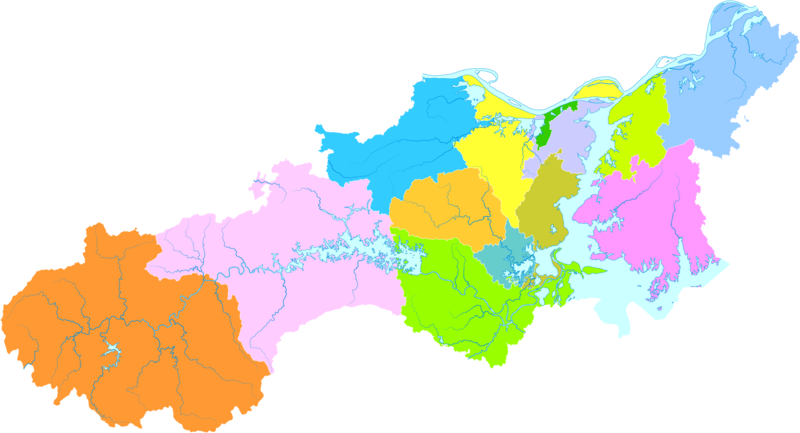
Xunyang * Lianxi Chaisang * |
History
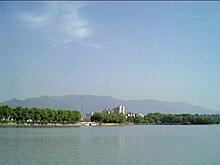
Ancient history
In ancient times it was told that nine rivers converged near where Jiujiang sprang up to become Jiangxi's main water port today. From the Xia to the Shang dynasty, the capitals of several states were located in area of Jiujiang.[citation needed] In the Spring and Autumn period (770–476 BCE) Jiujiang bordered between the states of Wu (downstream, to the east) and Chu (upstream, to the west).
Imperial history
Jiujiang has also been known as Jiangzhou (江州) and Xunyang (浔阳) in former times. During the
British concession and European settlement history
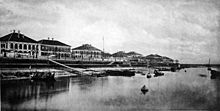
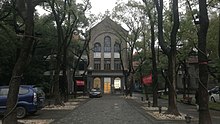

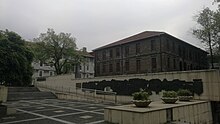

The arrival of the Europeans
A member of Lord Elgin's committee arriving in 1858 to survey Chinese ports for treaty status noted: "We found it to the last degree deplorable." A single dilapidated street, composed only of a few mean shops, was all that existed of this once thriving populous city. The remainder of the vast area composed within its massive walls 9–10 kilometers in circumference, contained nothing but ruins, weeds and kitchen gardens. After Jiujiang becoming an open treaty port in 1862, it was exporting Jiangxi's vast rice crop. In 1904, more than 160,000 kilos of opium were moved through its customs house. The New York Methodist Mission Society's superintendent, Virgil C. Hart, arrived in Kiukiang in 1866 and bought a piece of property just east of the city wall. This is where the city's first Methodist church and Western hospital was built, with the hospital renamed the No. 1 Hospital, and the oldest/continuous operating hospital in Jiangxi Province.[9] In 1896 Drs. Mary Stone (Shi Meiyu) and Ida Kahn (Kahn Cheng) arrived back in Jiujiang, being China's first two native female Western-educated doctors; having graduated from the University of Michigan Medical School. They were provided with funds collected by Dr. I. N. Danforth (from Chicago residents), to build the Elizabeth Skelton Danforth Hospital and administered entirely by the native Chinese. This was later renamed Jiujiang Women's and Children's Hospital, and the nursing education by Drs. Stone and Kahn would later be the impetus for the founding of Jiujiang University and Jiujiang Medical School.[10]
It became one of the three centers of the tea trade in China along with Hankou and Fuzhou. The Russians had two brick tea producing factories, but ceased operations after 1917. On October 16, 1927, there was an explosion of ammunition on the Chinese troopship Kuang Yuang near Jiujiang.[11] The British surrendered their concession in 1927 after being robbed and its Chinese workers mutineered their posts to the marauding crowds. An economic recession had set in over the decades as Indian and Chelonian tea made for greater competition. A military advance was being staged upriver in Wuhan by the Kuomintang in 1927 and all the remaining expatriate community fled on British and American warships towards safer waters of Shanghai, to never return.[citation needed] Jiujiang languished as a port and much of its export trade was siphoned off with the connecting of Nanchang to coastal rail lines built in 1936–37.
The establishment of the British concession
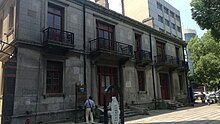
After China's defeat in the Second Opium War, China and Britain signed the Treaty of Tientsin. At the beginning of the eleventh year of Xianfeng (1861), the British counsellor, Harry Parkes, went to the new port on the Yangtse River by naval vessel according to the treaty to investigate the situation and select the site of concession to be opened. After the concession sites of Zhenjiang and Hankou were delimit, on March 22, Harry Parkes returned to Jiujiang from Hankou and decided to open up a commercial port in Jiujiang.[12]
In the 11th year of xianfeng (1861), Zhang Jixin, general minister of Jiangxi province, signed with Harry Parkers the treaty of opening up the British concession in Jiujiang, the Treaty of Land Lease in Jiujiang. The concession was located in a narrow area on the west of Jiujiang, between the Yangtze River and Gantang Lake, to the west of Longkai River, with a length of 150 zhang from east to west and a depth of 60 zhang from south to north, covering an area of 150 acres. The southern part of the concession includes part of PenPu Port.[13]
The development of Kuling in Mount Lu
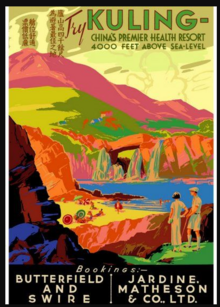
In the early 20th century,
Kuling, on the slopes of a wide valley of Mount Lu, was established in 1895 by the missionaries Edward Selby Little, Dr. Edgerton Haskell Hart and three others, as a sanitarium and rest resort for Western missionaries in southern China. They built their houses in the colonial style of architecture, and added churches, schools, and sports facilities. It was named by Little, as a pun: it is wonderfully cooling after the summer heat in the plains below. It was also a word that sounded conveniently Chinese to the local people, and has been adopted by them. Kuling was run by the missionaries in a Kuling Council that sold the plots of the land and with the proceeds paid for local services and security. In 1910, Caroline Maddock Hart and four others met to found the Nurses Association of China; with Caroline Maddock Hart being its first president.
Modern history
Until 1949 Jiujiang had very little industry except for local handicrafts. Manufacturing is Jiujiang's backbone today with auto, machinery, petrochemical, shipbuilding and textiles as its cornerstones. After the completion of the Yangtze River Bridge in 1992 and the Beijing to Kowloon (Hong Kong) and Wuhan to Shanghai rail systems laid, a convenient ground corridor was provided and a regional airport now serves most of China's capital cities.
In 2005, an earthquake hit Ruichang. Kuling American School Association donated 200 sets of desks and chairs and more than 50 sets of Oxford English-Chinese Dictionary to a local primary school near Ruichang.[15][16]
Economy
Economic and Technological Development Zones
Latest Ranking in the Chinese Cities
In 2021, Jiujiang's GDP is 373.528 Billion Yuan. Jiujiang's GDP ranks 70th among all Chinese cities.[20]
Demography
The city administers a total population of approximately 4,600,276 at the 2020 census of whom approximately 2,814,240 are urban living in the urban area.[6] The population density is 240 per km2. Han Chinese make up 99.8% of the population. Registered residents include 25 ethnic minorities. Six of them are major minorities in Jiujiang. They are: Hui, Miao, Zhuang, Tujia, and She.
Jiujiang dialect is unlike typical Gan dialect of Jiangxi. Jiujiang dialect is a variety of Lower Yangtze Mandarin and is close to Wu languages.[citation needed]
Climate
| Climate data for Jiujiang (1991–2014 normals, extremes 1981–2010) | |||||||||||||
|---|---|---|---|---|---|---|---|---|---|---|---|---|---|
| Month | Jan | Feb | Mar | Apr | May | Jun | Jul | Aug | Sep | Oct | Nov | Dec | Year |
| Record high °C (°F) | 21.3 (70.3) |
29.1 (84.4) |
31.8 (89.2) |
34.1 (93.4) |
37.0 (98.6) |
38.6 (101.5) |
40.9 (105.6) |
40.9 (105.6) |
38.9 (102.0) |
35.6 (96.1) |
29.7 (85.5) |
22.8 (73.0) |
40.9 (105.6) |
| Mean daily maximum °C (°F) | 8.0 (46.4) |
11.0 (51.8) |
15.5 (59.9) |
22.1 (71.8) |
27.1 (80.8) |
29.8 (85.6) |
33.7 (92.7) |
32.6 (90.7) |
28.7 (83.7) |
23.5 (74.3) |
17.2 (63.0) |
10.9 (51.6) |
21.7 (71.0) |
| Daily mean °C (°F) | 4.9 (40.8) |
7.5 (45.5) |
11.5 (52.7) |
17.8 (64.0) |
22.8 (73.0) |
26.1 (79.0) |
29.8 (85.6) |
28.7 (83.7) |
24.8 (76.6) |
19.6 (67.3) |
13.3 (55.9) |
7.3 (45.1) |
17.8 (64.1) |
| Mean daily minimum °C (°F) | 2.6 (36.7) |
5.0 (41.0) |
8.6 (47.5) |
14.5 (58.1) |
19.5 (67.1) |
23.3 (73.9) |
26.7 (80.1) |
25.9 (78.6) |
22.1 (71.8) |
16.7 (62.1) |
10.4 (50.7) |
4.8 (40.6) |
15.0 (59.0) |
| Record low °C (°F) | −4.2 (24.4) |
−5.3 (22.5) |
−1.0 (30.2) |
3.6 (38.5) |
10.0 (50.0) |
14.5 (58.1) |
19.8 (67.6) |
17.8 (64.0) |
14.3 (57.7) |
5.6 (42.1) |
−0.7 (30.7) |
−6.7 (19.9) |
−6.7 (19.9) |
| Average precipitation mm (inches) | 80.7 (3.18) |
99.2 (3.91) |
147.6 (5.81) |
166.6 (6.56) |
186.0 (7.32) |
229.3 (9.03) |
170.0 (6.69) |
123.3 (4.85) |
74.3 (2.93) |
73.5 (2.89) |
73.5 (2.89) |
54.0 (2.13) |
1,478 (58.19) |
| Average precipitation days (≥ 0.1 mm) | 12.6 | 12.4 | 15.9 | 14.5 | 13.9 | 14.1 | 10.7 | 11.2 | 8.1 | 8.5 | 10.3 | 9.4 | 141.6 |
| Average snowy days | 3.6 | 2.2 | 0.6 | 0 | 0 | 0 | 0 | 0 | 0 | 0 | 0.1 | 1.5 | 8 |
| Average relative humidity (%)
|
76 | 75 | 75 | 74 | 74 | 79 | 74 | 77 | 76 | 72 | 74 | 72 | 75 |
| Mean monthly sunshine hours | 86.0 | 90.3 | 109.6 | 135.3 | 148.8 | 133.9 | 197.0 | 188.7 | 158.0 | 152.5 | 124.4 | 113.0 | 1,637.5 |
| Percent possible sunshine | 26 | 29 | 29 | 35 | 35 | 32 | 46 | 47 | 43 | 43 | 39 | 36 | 37 |
| Source: China Meteorological Administration[21][22] | |||||||||||||
Industry
Primary industries and tertiary sector include:[23]
- Manufacturing
- Petrochemical Refinement
- Tourism
- Import/Export (through river port)
- Agricultural Chemical Production
Transport
Road:[24]
- G56 Hangzhou–Ruili Expressway
- G70 Fuzhou–Yinchuan Expressway
- Jiujiang Ring Expressway
- Chang-Jiu Expressway
- Jiu-Rui Expressway
- G45 Daguang Expressway
- Yongwu Expressway
- Penghu Expressway
- Xiu-ping Expressway
- Du-Jiu Expressway
- Dong-jiu Expressway
Rail
- Beijing-Kowloon
- Tongling–Jiujiang
- Hefei–Jiujiang
- Wuhan–Jiujiang
- Nanchang–Jiujiang Intercity Railway
- Chang-jiu intercity railway
- Wu-jiu high speed railway
- Jiujing-qu railway
- He-an-Jiu passenger dedicated line
- Fu-gang-jiu passenger dedicated line
- Chang-jiu high speed railway.
Air
- Jiujiang Lushan Airport (JIU)
Port
Jiujiang Port is the largest port in Jiangxi Province located at the junction of the Yangtze River, Poyang Lake and the Beijing-Kowloon Railway. From west to east, this port consists of five docks namely Ruichang, Chengxi, Chengqu, Hukou and Pengze. As an important port situated on the lower and middle reaches of Yangtze River and one of the 5 main ports on the river, many domestic and international marine routes have been established, In the main, the freight handled consists of mineral building materials, coals, metal and nonmetal ores and petroleum. [27]
Yangtze Bridges
At present, Jiujiang has two Bridges built across the Yangtze River. They are Jiujiang Yangtze River Bridge and Jiujiang Yangtze River Expressway Bridge. The third bridge across the Yangtze River in Jiujiang is under construction. The fourth bridge across the Yangtze River in Jiujiang is being designed [28] [29]
Colleges and universities

- Lianxi District. The location is most easily reached by the 101 bus from the city center.[30]
- Jiangxi Vocational College of Finance and Economics: a small picturesque college located right by the lake. This college is well situated within the city.[31]
- Lianxi District near University of Jiujiang.[32]
- Lianxi District near University of Jiujiang.[33]
- Jiangxi Fenglin College: a vocational college located in Yongxiu county. Yongxiu county belongs to Jiujiang.[34]
- Jiujiang Vocational College of Polytechnic: a vocational college located in Jiujiang Economic and Technological Development Zone.[35]
- Gongqing Institute of Science and Technology: a vocational college located in Gongqingcheng. Gongqingcheng belongs to Jiujiang.[36]
- Gongqing College of Nanchang University: a local college located in Gongqingcheng.[37]
- Science and Technology College of Jiangxi Normal University: a local college located in Gongqingcheng.[38]
- Modern Economics and Management College of Jiangxi Finance and Economics University: a local college located in Gongqingcheng.[39]
- Science and Technology College of Nanchang Aviation University: a vocational college located in Gongqingcheng.[40]
- Science and Technology College of Nanchang University: a local college located in Gongqingcheng.[41]
- Nanchang Business College of Jiangxi Agriculture University: a local vocational college located in Gongqingcheng.[42]
International relations
Former Diplomatic Representatives in Jiujiang
- British Consulate General Jiujiang was established in 1861
- Japanese Consulate General Jiujiang was established on July 16, 1915
Twin towns — Sister cities
Jiujiang is
Tourism

- Mount Lu: one of the most famous mountains in China. It is located in the south of the urban center and listed as a World Heritage Site.[44]
- Global Geoparks Network. Mount Lu Geopark is a place of striking beauty. It has spectacular peaks, lakes, cliffs, waterfalls and important Buddhist and Taoist temples.[45]
- Kuling: as a homonym for cooling. It is a mountain town in the Mount Lu National Park. It was established in 1895 by the missionaries Edward Selby Little, Dr. Edgerton Haskell Hart and three others, as a sanitarium and summer resort for Western missionaries in southern China.[46]
- British Concession Museum: located on Binjiang road. It was established by local government from transforming buildings left from the former British Concession of Jiujiang.[47][circular reference]
- Yuliang South Road Historical and Cultural Block: a street combines Chinese and Western cultures. Beside the street are:[48]
- the old Catholic school
- the old monastery
- the Catholic church
- Taling Park
- the old Perkins Villa
- Nengren temple
- Western Goods Exhibition Window
- Lushan Hotspring: located in Hotspring town, Lushan City. Lushan City is a county-level city belong to Jiujiang.[49]
- Haiyun Sand Beach: located in Balihu Park. It is the only high standard man-made beach in Jiangxi Province. It is a famous scenic spot and entertainment resort in Jiujiang.[50]
- Xunyang District. It is near shoreline of the Yangtze River. Covering an area of some 765 acres (around 509,490 sqm), with distance of 5.2 km long from east to west. It is only 4.5 km away from Jiujiang Station, 1.6 km away from Fuzhou-Yinchuan Expressway, and about an hour's drive from Changbei Airport. Its rich tourism resources include river, ancient building, garden and museum as follows:[51]
- Pipa Pavilion
- Xunyang Tower
- Suojiang Pagoda
- British Concession Museum
- Baishui Lake Park
- Xunyang River Cruise Ship
- Mount Lu West Sea: is located about 90 kilometers to the south of Mount Lu. It is National 5-Star Scenic Spot. There are thousands of islands in the area just like Maldives. In 2007, between June and August, American reality program Survivor filmed its fifteenth season, Survivor: China, in the area. The program host Jeff Probst claimed that this was the first American television series filmed entirely in China.[52]
- Nanshan Park (南山公园): completed in early 2013. This park, home to a new pagoda, is covered in flora and lights up the Jiujiang sky at night.[53]
- Yanshui Pavilion: located in city center, near Gantang lake. It is a well known scenic spot in Jiujiang.[54]
- Huiyuan (Buddhist), founder of Pure Land Buddhism. Pure Land Buddhism later spread to Japan and gained its prominence there. In 1175, Hōnen established Pure Land Buddhism as an independent sect in Japan known as Jōdo-shū. Pure Land schools have nearly 40 percent of Japanese Buddhism practitioners, only second to Chan schools.[55][56]
- The temple provide free vegetarian lunch and free guest house. Visitors can stay at guest house in temple for free up to three days. The guest house is gender separated, and visitors have to share room with others.[56]
- Mount Lu Four Seasons Flower City (Botanical Garden): located in Bali lake New Area. It is Jiujiang's largest flower plant park.[59]
- Stone Bell Hill: just downriver from Jiujiang is Hukou where the Yangtze River and waters of Boyang Lake converge with an abrupt color change. People have been coming here for centuries to listen to the stone-bell sound resonating from the cliffs overlooking this spot. A few theories are provided why this rare geographical phenomenon happens. Li Daoyuan from the Northern Wei period (386–534) theorizes that it is because the hill has a bell-shaped appearance and hollow inside, thus providing the sound when struck. Or it may be because of the water lapping within the limestone nooks and fissures around its base, as famous litterateur from the same time Su Shui discovered. Su Dongpo also did three trips around its perimeter, before settling on this last explanation for its unique sound also. Many Chinese literati's have left more than twenty calligraphy masterpieces carved upon its rocks, with some dating back to the Tang dynasty (618–907 CE).[60]
Notable residents
- Mary Stone (Shi Meiyu) (1873–1954), one of the first western trained Chinese female physicians. Founder of Elizabeth Skelton Danforth Hospital (now called Jiujiang Women and Children's Hospital) in Jiujiang.[61][62]
- Lo-Yi Chang (1907–1988), was born in T.V. Soong, then Premier of the Republic of China. She has made a significant contribution to the promotion of China overseas.[63]
- former Japanese consulate of Jiujiang. Masato Matsuura said :I was born in the former Japanese consulate of Jiujiang. Jiujiang is my second hometown. I am deeply attached to the beautiful landscape here.[68]
- Chiang Yee (1903–1977), born in Jiujiang. He was a Chinese poet, author, painter and calligrapher. His translation of Coca Cola is remembered by all Chinese.[69]
- Mount Lu. He was an English writer, artist, poet, and illustrator. He was well known for being the illustrator of Alice's Adventures in Wonderland.[70]
- Maggie Mac Neil (2000- ), born in Jiujiang and adopted to Canada at an early age[71]
- Sylvia Wu (1915–2022), born in Kiukiang and later became a Los Angeles restaurateur and a writer.
- Ilien Tang (died 1920), Methodist missionary educator born in Jiujiang[72]
See also
References
- ^ 地理交通 [Geography and transport] (in Simplified Chinese). Jiujiang People's Government. Archived from the original on 18 November 2019. Retrieved 1 June 2018.
- ISBN 978-7-5037-7809-4. Archived from the originalon 2018-05-11. Retrieved 2017-06-05.
- Postal romanization
- ^ "改革开放40年:九江港成为名副其实的"亿吨大港"". Jiujiang News Network. Retrieved 22 July 2021.
- ^ ""百年老港"江西九江港稳固亿吨大港地位". Sohu.com. Retrieved 22 July 2021.
- ^ a b "九江市第七次全国人口普查公报" (PDF). Jiujiang Statistics Bureau Website. Archived from the original (PDF) on 3 November 2021. Retrieved 22 July 2021.
- ^ "China's Top 10 Most Livable Cities". hnloudi.gov.cn. Hunan Loudi Official Government. 2012-03-28. Archived from the original on 2013-04-10. Retrieved 2014-08-04.
- People.com.cn. 29 May 2014. Archived from the originalon 12 June 2018. Retrieved 7 June 2018.
- ^ "Man On A Mission" by Stanley Crawford
- ^ "The Middle Kingdom's Miracle Maidens" by Stanley Crawford
- ^ "1,200 Die as Yangtse Troopship Blows Up". The New York Times. October 17, 1926.
- ^ Bickers, R., & Jackson, I. (2016). Introduction: law, land and power: treaty ports and concessions in modern China. In Treaty Ports in Modern China (pp. 11–32). Routledge.
- ^ Bickers, R. (2013). 8. British Concessions and Chinese Cities, 1910s–1930s. In New Narratives of Urban Space in Republican Chinese Cities (pp. 155–195). Brill.
- ^ Nield, R. (2015). China’s Foreign Places: The Foreign Presence in China in the Treaty Port Era, 1840–1943. Hong Kong University Press.
- ^ "牯岭芝罘学校外籍校友阔别60多年重游庐山". Jiujiang News Network. Retrieved 22 July 2021.
- ^ "Kuling American School Association美国学堂". Kuling American School Association Website. Retrieved 22 July 2021.
- ^ "九江综合保税区". Jiujiang Free Trade Zone Website. Archived from the original on 20 July 2021. Retrieved 20 July 2021.
- ^ "九江国家级经济技术开发区". Jiujiang National Economical and Technological Development Zone Website. Archived from the original on 22 July 2021. Retrieved 20 July 2021.
- ^ "九江共青城国家高新技术产业开发区". Jiujiang Gongqingcheng National High-tech Industrial Development Zone. Archived from the original on 20 July 2021. Retrieved 20 July 2021.
- ^ "2021年中国城市GDP百强榜". tencent.com. Retrieved 22 July 2021.
- ^ 中国气象数据网 – WeatherBk Data (in Simplified Chinese). China Meteorological Administration. Retrieved 28 June 2023.
- ^ "Experience Template" 中国气象数据网 (in Simplified Chinese). China Meteorological Administration. Retrieved 28 June 2023.
- ^ "产业". Jiujiang People's Government Website. Archived from the original on 21 July 2021. Retrieved 21 July 2021.
- ^ "公路". Jiujiang Government Website. Archived from the original on 21 July 2021. Retrieved 22 July 2021.
- ^ "铁路". Jiujiang Government Website. Archived from the original on 21 July 2021. Retrieved 22 July 2021.
- ^ "机场". Jiujiang Government Website. Archived from the original on 21 July 2021. Retrieved 22 July 2021.
- ^ "港口". Jiujiang Government Website. Archived from the original on 21 July 2021. Retrieved 22 July 2021.
- ^ "大桥". Jiujiang Government Website. Archived from the original on 21 July 2021. Retrieved 22 July 2021.
- ^ "九江长江大桥". China-qiao.com. Retrieved 23 July 2021.
- ^ "九江学院". Jiujiang University Website. Retrieved 19 July 2021.
- ^ "江西财经职业学院". Jiangxi Vocational College of Finance & Economics Website. Archived from the original on 19 July 2021. Retrieved 19 July 2021.
- ^ "九江职业技术学院". Jiujiang Vocational and Technical College Website.
- ^ "九江职业大学". Jiujiang Vocational University Website. Archived from the original on 19 July 2021. Retrieved 19 July 2021.
- ^ "江西枫林涉外经贸职业学院". Jiangxi Fenglin College of Foreign Economy & Trade Website. Archived from the original on 27 January 2021. Retrieved 19 July 2021.
- ^ "九江理工职业技术学院". Jiujiang Vocational College of Polytechnic Website. Retrieved 19 July 2021.
- ^ "共青职业技术学院". Gongqing Institute of Science and Technology Website. Retrieved 20 July 2021.
- ^ "南昌大学共青学院". Gongqing College of Nanchang Website. Retrieved 20 July 2021.
- ^ "江西师范大学科学技术学院". Science and Technology College of Jiangxi Normal University. Retrieved 20 July 2021.
- ^ "江西财经大学现代经济管理学院". Modern Economics and Management College of Jiangxi Finance and Economics University Website. Retrieved 20 July 2021.
- ^ "南昌航空大学科学技术学院". Science and Technology College of Nanchang Aviation University Website. Retrieved 20 July 2021.
- ^ "南昌大学共青学院". Science and Technology College of Nanchang University Website. Retrieved 20 July 2021.
- ^ "江西农业大学南昌商学院". Nanchang Business College of Jiangxi Agriculture University Website. Retrieved 20 July 2021.
- ^ "Sister Cities". jiujiang.gov.cn. Jiujiang. Archived from the original on 2020-07-14. Retrieved 2020-07-12.
- ^ "Mount Lu Scenic Area". Trip.com. Retrieved 19 July 2021.
- ^ "Mt. Lushan National Park". Tripadvisory.com. Retrieved 20 July 2021.
- JSTOR 24776512. Retrieved 20 July 2021.
- British Concession in Jiujiang
- ^ "Xunyang District "13th Five-Year" Historical and Cultural Block Construction Documentation". Xunyang People's Government Website. Archived from the original on 19 July 2021. Retrieved 19 July 2021.
- ^ "Lushan Hot Spring – Jiujiang". Visit Our China. Retrieved 19 July 2021.
- ^ "Haiyun Sand Beach". Trip.com. Retrieved 19 July 2021.
- ^ "Xunyang River Scenic Area". Xunyang River Scenic Area Website. Retrieved 19 July 2021.
- ^ "庐山西海". Mountain Lu West Sea Website. Archived from the original on 2021-07-21. Retrieved 2021-07-21.
- ^ "Nanshan Park". Trip.com. Retrieved 19 July 2021.
- ^ "Yanshui Pavilion". Tripadvisor. Retrieved 19 July 2021.
- ^ "Donglin Temple". Trip.com. Retrieved 19 July 2021.
- ^ a b "东林祖庭". Donglin Temple Website. Retrieved 20 July 2021.
- ^ "Donglin Buddha". Trip.com. Retrieved 20 July 2021.
- ^ "东林大佛". Donglin Temple Website. Retrieved 20 July 2021.
- ^ "九江四季花城". Jiujiang News Network. Retrieved 20 July 2021.
- ^ "Stone Bell HIll (Shizhong shan)". tripadvisor.com. Retrieved 19 July 2021.
- ^ Tobin, James. "The New Women of China". Medicine at Michigan, Fall'10, Volume 12, Number 3. University of Michigan. Archived from the original on 28 March 2016. Retrieved 15 February 2014.
- ^ "Shi Meiyu (Mary Stone) |". Archived from the original on 2020-04-28. Retrieved 2020-04-27.
- ^ 池昕鸿 (22 July 2015). "国内名人传记丛书(套装共6册)". books.google. Retrieved 22 July 2021.
- ^ "赛兆祥墓碑". mylushan.com. Retrieved 22 July 2021.
- ^ "Pearl S. Buck house in Zhenjiang". Retrieved 22 July 2021.
- ^ "松浦正人". ZHZ.wiki. Retrieved 22 July 2021.
- ^ "7/30 日本全國市長會會長松浦正人就任祝賀會". Fukuoka Branch, Taipei Economic and Cultural Office in Osaka Website. Retrieved 22 July 2021.
- ^ "日本全国市长会代表团来访九江租界旧址". Jiujiang Cultural and Tourism Development Group Website. Retrieved 21 July 2021.
- ISBN 0-313-31408-X.
- ISBN 1582341745.
- ^ Tang, Didi (2021-07-27). "Maggie Mac Neil's Olympic gold for Canada thrusts China's one-child policy back into spotlight". The Times. Retrieved 2021-08-01.
- ^ Honsinger, Welthy B., "Ilien Tang" Woman's Missionary Friend 52(20)(August 1920): 285.
External links
- People's Government of Jiujiang (Chinese language) Archived 2007-02-28 at the Wayback Machine
- Mount Lu Website (Chinese language) Archived 2011-07-03 at the Wayback Machine
- Jiujiang News Network (Chinese language) Archived 2021-07-20 at the Wayback Machine
- Kuling American School Association
